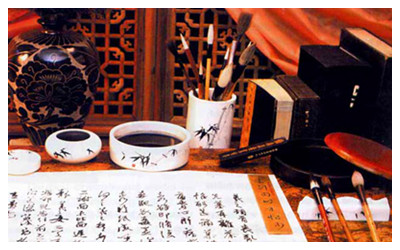Skype: neodalle-travel
Tel: +86 135 7447 2266
E-mail: sales@visitaroundchina.com

 Four Treasures of the Study, also known as Han Chinese traditional culture instrument tool, is an expression used to refer to the writing brush, ink stick, paper and ink stone used in Chinese calligraphy. Four Treasures’ the name originated in the Northern and Southern Dynasties.
Four Treasures of the Study, also known as Han Chinese traditional culture instrument tool, is an expression used to refer to the writing brush, ink stick, paper and ink stone used in Chinese calligraphy. Four Treasures’ the name originated in the Northern and Southern Dynasties.The brush pens are classified by the type of hair used: goat hair (yáng háo 羊毫), wolf hair (láng háo 狼毫), and purple hair (zǐ háo 紫毫). Wolf hair brushes are actually made from weasel hair and purple hair brushes from rabbit hair. Goat hair brushes are soft, flexible, and absorbent. Purple hair brushes produce bold lines and are best suited to calligraphy. Sometimes, to achieve a balance between steely and feathery lines, a brush that combines hair from two different types of animals is used. Not only is the handle made from bamboo, wood, lacquer, and porcelain, but also from precious materials including mother-of-pearl inlay, ivory, and jade. Usually, painters and calligraphers have several types of brushes on hand to adapt to individual purposes and preferences.
The Chinese brush may be big or small, stiff or soft. The important thing is that it serve your own practical purpose. Generally, a big, soft brush is used to write large characters and a small, stiff one to write small characters. The point must be "round like an awl (zuàn 钻)" that can be "pressed like a chisel (záo zi 凿子)". The Chinese brush point should have the following characteristics: roundness, pointedness, evenness and strength. Roundness means the point should be rounded and robust. Pointed-ness means it should be as sharp or pointed as an awl. Evenness means that when you spread the brush and hold it down, the brush is even. Strength means the point is flexible or elastic. You can moisten a new brush in your mouth, then press it forward and backward on your thumb. The brush will go round and round smoothly. When you pick the brush up, it will return to its former shape naturally becoming as sharp and pointed as before. This means your brush is all right.
Th Ink-stick is the pigment of Chinese traditional painting and calligraphy. Initially, natural ink or half-natural ink was generally used. Eventually, artificial ink appeared. The Ink stick is made from a mixture of soot and resin, molded into stick form. The three types of soot most commonly used pine, oil, and lacquer soot. A good inkstick is finely grained and has an even and smooth texture. It is firm and not sticky. It is pure, solid black in color, without murkiness or roughness.
A new brush has a sticky coating that must be removed by immersing the brush in warm water (do not use hot water). The hair will then fluff out. Do not try to remove the glue by force. Do not use your teeth to remove the glue. The glue on brushes for writing small characters should be removed from two fifths of the length of the hair. The glue on brushes for writing medium-sized characters should be removed from half the length of the hair, and the glue on brushes for writing big characters should be removed from two thirds the length of the hair. It is not advisable to remove all the glue from the brush. If it is removed entirely, the brush will not have the required force or rigor. How much glue should be removed just depends on the convenience of the user.
The brush for writing big characters must be washed in clean water after use. Be sure no ink is left on the brush, which should be carefully groomed. The brush should be hung up with the tip downward. The brush for writing small characters must be put in a sheath after use, to protect it from gluing up. If the brush is not used for a long time, it must be kept in a box or a bag. Camphor balls (zhāng nǎo wán 樟脑丸) should be used to protect the brush from being moth-eaten.
Paper was invented by a Chinese named Cai Lun around 105 A.D. Slowly, paper supplanted traditional bamboo slips and silk. Seven hundred years later, paper-making technology was absorbed by Islamic countries. Around the 13th century, paper began replacing papyrus and parchment in Europe.
To use the traditional inkstick, an inkstone is required. As the name suggests, most inkstones are made of stone. The stone used must be of relatively fine whetstone (mò shí 磨石) materials so the bristles of the brush pen are not damaged and to facilitate the grinding of the inkstick could. A little water is added to the inkstone, and the inkstick is ground. The result is ink, and the inkstone acts as an inkwell. Inkstones are extremely durable. In ancient times, artisans would have their names or other words engraved on their inkstones to be passed on to future generations.
While retaining the strengths of the traditional "four treasures of the study," modern technology and materials are being applied to make these treasures even more practical and suited to the needs of the user. The dependence of the Chinese arts of calligraphy and painting on this set of "treasures of the study" to express the ideas, writing system, experience, and feelings of the Chinese people has brought forth an eternal cultural institution. As a result, Chinese calligraphy and painting has sparked much interest and discussion in the international art world.
 Ask Questions ?
Ask Questions ?